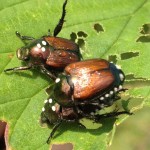Take a deep breath; help is on the way!

While scouting a hopyard in central Vermont, UVM Extension Entomologist Scott Lewins photographed these Japanese beetles last week with some deadly companions on their backs (Figure 1). The white dots on the thorax of the Japanese beetle in the picture are eggs of a parasitic fly brought here years ago to help control this destructive invasive species.
The winsome fly, Istocheta aldrichi (Figure 2), is a parasitic fly native to Japan, where it is one of the most effective parasites of Japanese beetles. Female flies lay their eggs on the thorax of newly-emerged Japanese beetles. After the eggs hatch, the parasitic maggots burrow into their Japanese beetle host, killing them in five to six days. The beetle rapidly dies as the maggots eat it from the inside out. This often means that the targeted beetles never reproduce. The fly completes its lifecycle within the body of the dead beetle, emerging the following year.

The USDA first introduced the winsome fly in the United States in 1922 to try to combat Japanese beetles. Their introduction has been slow to take hold throughout the US, but has become well-established in New England since their introduction. The winsome fly and Japanese beetles are not as well-synchronized within the US as they are in their native Japan. Unfortunately, the fly emerges earlier than the beetle so we don’t realize the full benefit of Japanese beetle control. Despite this asynchrony, parasitization rates of more than 20% have been observed.
In order to encourage winsome flies in the landscape, there are ways to manipulate the habitat to benefit them. Adult flies feed on the nectar of umbelliferous flowers like yarrow, hemlock, Queen Anne’s lace and parsnip. Providing food sources for adult flies will attract them to the area, and when Japanese beetles begin to emerge, the winsome fly will be ready to do what it was brought here for.
For more information on Japanese beetles and their management, check out the following article on Japanese beetles:http://www.uvm.edu/extension/cropsoil/wp-content/uploads/Japanese_beetle_in_hops.pdf. For more information on hops in general visit us on the web at www.uvm.edu/extension/cropsoil/hops.
